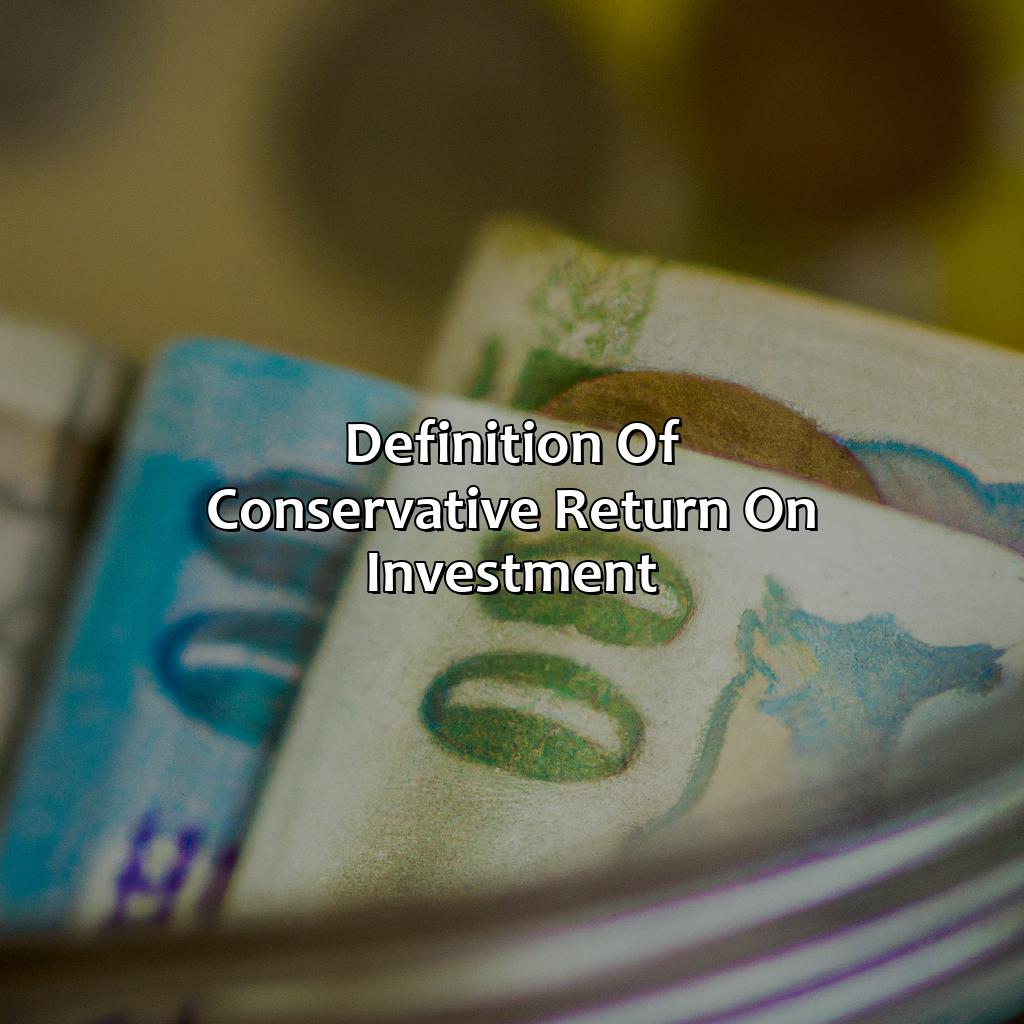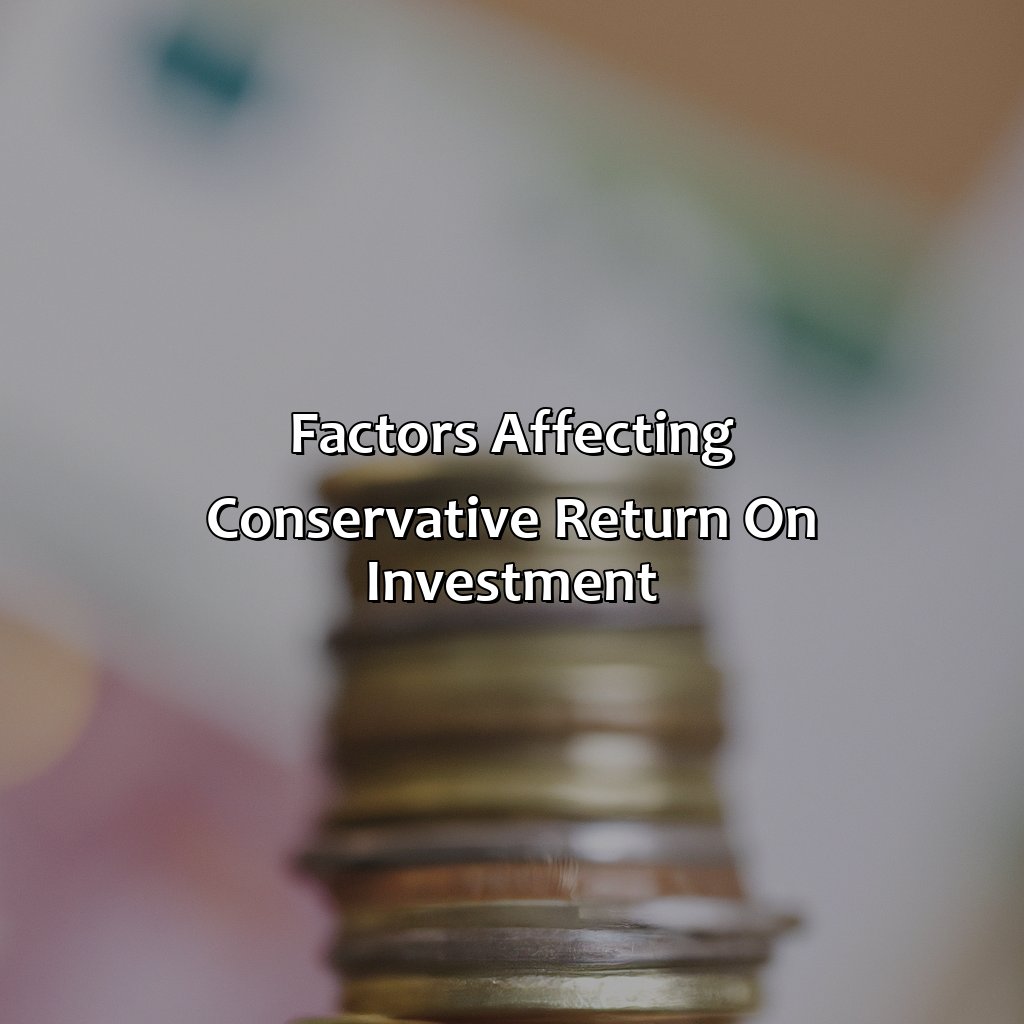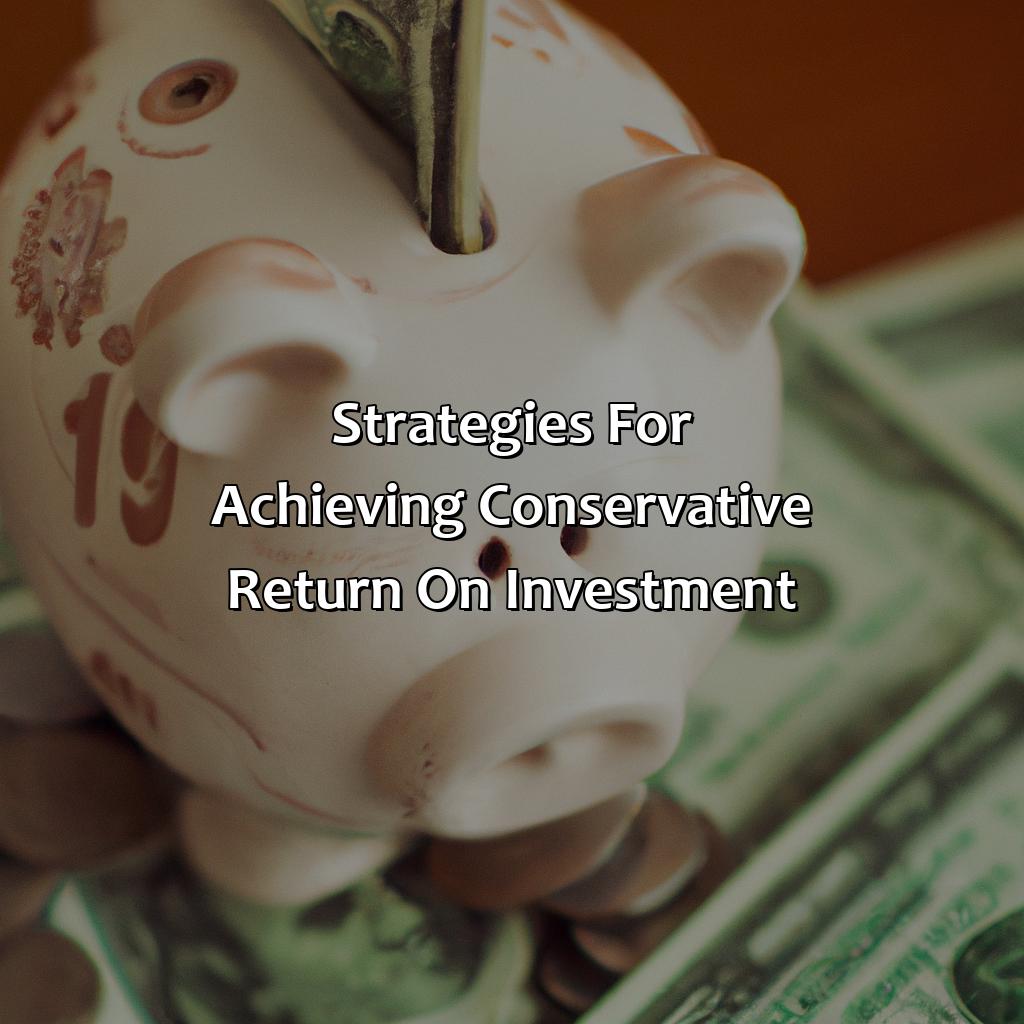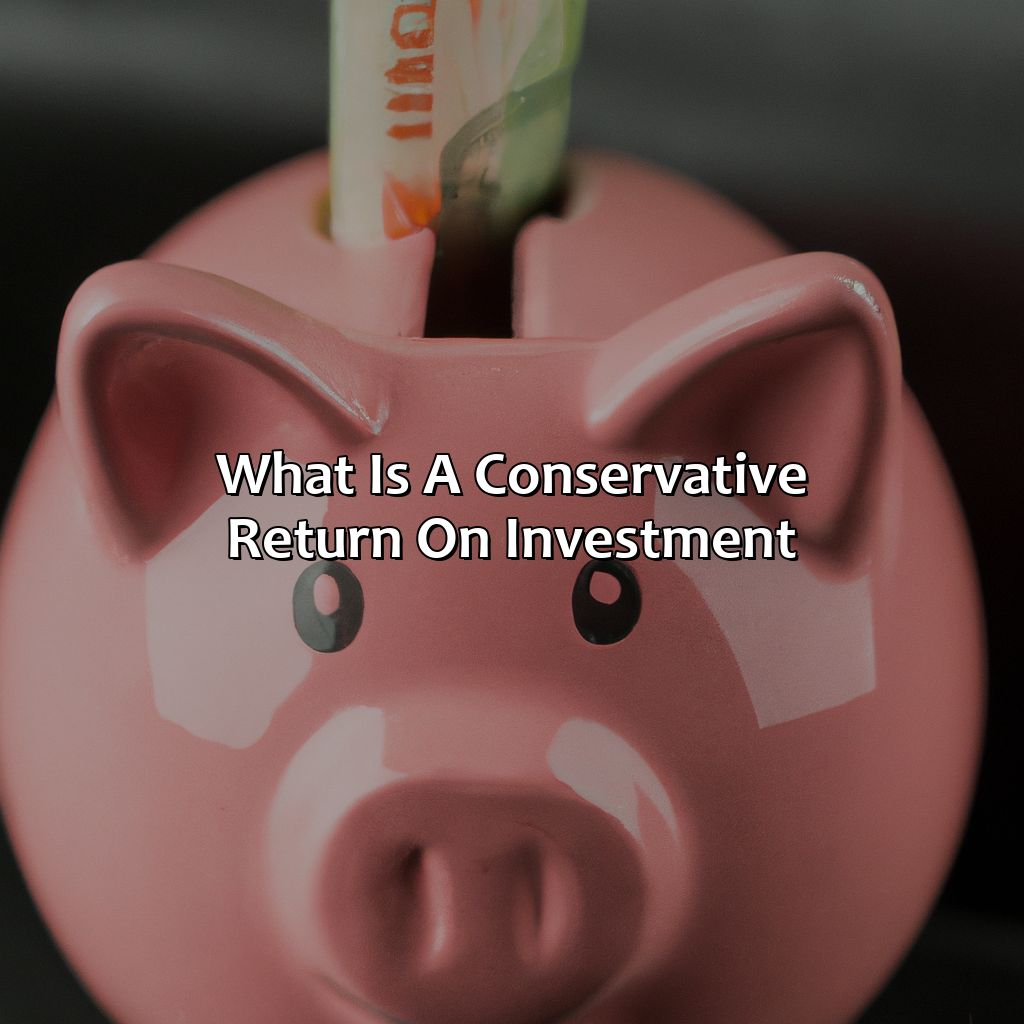What Is A Conservative Return On Investment?
Key Takeaways:
- Conservative return on investment is a strategy that prioritizes low-risk investments with stable returns over high-risk investments with potentially higher returns.
- The factors affecting conservative return on investment include an investor’s risk appetite, investment vehicles chosen, and market conditions.
- Strategies for achieving conservative return on investment include diversification, long-term investing, and fixed-income investments such as bonds and CDs.
Do you want to make a profitable return on your investments? With a conservative approach to investing, you can safely navigate the markets and earn returns with minimal risk. This article will discuss what a conservative return on investment is and how to maximize it.
Definition of Conservative Return on Investment
Grasp the concept of conservative return on investment! Start with an explanation of ROI. Understand what “conservative return” means. Get to know the advantages it offers. Then, make wise investments for your future!

Image credits: retiregenz.com by Harry Jones
Explanation of ROI
ROI Definition – What is a conservative return on investment? An ROI can be defined as any profit made from investment activities. Determining a conservative return on investment involves finding the lowest possible rate of return expected from an investment. Conservative ROI is typically lower than average ROI, but it also carries less financial risk.
When investors consider making investments, they often calculate their potential profits based on projected returns and historical data. However, these calculations are only estimates and may not accurately predict actual rates of return. Therefore, calculating a conservative ROI provides a safety net for investors who want to minimize risk while still generating income from their investments.
It is important to note that different types of investments will have different levels of associated risk and expected returns. Hence, when determining the conservative ROI of any particular investment, it’s necessary to study its previous trends. Investors should research past performance and current market conditions before investing in any new opportunities with potentially higher yield.
To increase the likelihood of low-risk investment opportunities and thus maximize the chance for minimal loss with the intent to gain moderate returns, one should opt for fixed term deposits with federally insured financial institutions or government bond programs like I-bonds.
Calculating a conservative return on investment is like trying to find a unicorn in a forest of financial jargon.
Defining conservative return
A conservative rate of investment implies a secure and low-risk financial approach taken by an investor to ensure consistency in their portfolios’ growth without sacrificing their principal amount. This rate of return is calculated through assets such as bonds or money market funds, providing stable and predictable returns with minimal risk. Investors can rely on this tactical move to ensure portfolio stability amidst insecure market conditions.
In a world of high volatility, where one can easily fluctuate from profit to loss in a blink of an eye, investors need to be sure that they don’t put all their eggs in one basket. Using this conservative rate instead ensures balanced growth throughout investment periods and provides long-term gains despite the short-term fluctuations.
Moreover, it is worth noting that unlike other investments such as stocks or real estate properties where they expose the individual’s principal amount on the line, conservative returns assure the safety of your initial investment amount.
In a true story illustrating this notion at the 2008 financial crisis, some savvy investors who relied heavily on aggressive equity investments suffered significant losses while others who took more strategic approaches found safety in fixed-income investments that remained stable despite turbulent market conditions.
Conservative return on investment – because sometimes playing it safe pays off more than taking a gamble.
Factors Affecting Conservative Return on Investment
Do you know what a conservative return on investment is? If not, let’s explore it.
We need to understand the factors that affect it, like risk appetite, investment vehicles, and market conditions. Let’s delve further and look into the critical sub-sections of this strategy. Risk appetite, investment vehicles, and market conditions are all key players in this type of investment strategy.

Image credits: retiregenz.com by Harry Arnold
Risk Appetite
Investment Risk Tolerance plays a significant role in determining Conservative Return on Investment. Every investor has their own risk tolerance level, and it differs from one person to another. Some investors consider investments that are low-risk, while others may choose to invest in a portfolio with high-risk securities. Understanding an investor’s risk appetite is crucial when deciding on an investment approach.
Conservative investors typically have a lower level of tolerance for market volatility than aggressive investors. Therefore, conservative investors look for financial products with relatively stable returns over the short- and long-term. By investing in low-risk products such as bonds, fixed-income securities, and mutual funds, investors may reduce their exposure to sudden fluctuations in the stock market, which can provide greater peace of mind and lower risk.
On top of considering investment risk tolerance levels, several other factors may influence the Conservative Return on Investment as well. Some examples include tax bracket status, cash flow requirements, diversification methods used within an investment portfolio all play a significant role in determining the conservative return on investment.
An experienced investor opted to invest heavily into low-risk securities throughout his life and amassed a fantastic fortune during his golden years. This example highlights how critical it is to be aware of one’s risk appetite when making decisions about different kinds of investments – even if they seem like the safe bets. Ultimately earning a solid conservative return on your investment comes down to understanding your individual needs relative to your financial goals.
Investment vehicles are like cars – some are flashy and fast, while others are slow and steady. Just remember, it’s not always about the speed, but the destination that matters most in investing.
Investment Vehicles
Investment Options Explored
Various investment options provide welcome diversification, solid returns and security of capital.
- Stocks and shares: These provide an excellent return-on-investment (ROI) potential, with a range of companies to invest in – from high-growth start-ups to established blue-chip firms.
- Bonds and fixed-interest securities: While not as lucrative as equities, bonds offer a low-risk form of income generation to investors.
- Real estate: Property investment can be a lucrative option with steadily rising prices if done correctly. However, it requires plenty of capital which may lock out many prospective investors.
- Mutual funds: These funds pool public contributions into diversified portfolios managed by professionals to minimize risks and maximize yields.
When considering the right investment vehicles one should assess the tax implications of their investments, particularly on expected ROI annually.
A colleague recounted how they factored in local China’s economic performance when investing in a property abroad and succeeded financially due to having this foresight.
The market may be unpredictable, but one thing’s for sure – investing in unicorn tears won’t give you a conservative return on investment.
Market Conditions
Amidst the current market state, it’s crucial to consider various influencing factors that can affect conservative ROI. One must evaluate economic indicators, interest rates, political stability, and market volatility before investing. These elements determine the prospect of growth or losses in a particular investment.
Depending on the prevailing macroeconomic climate and other conditions such as demographic trends, industrial progress, and global interconnectivity, certain sectors might perform better than others. Equally important is assessing the underlying assets’ risks and external factors affecting their value.
It’s necessary to note that political instability in any country could range from locally instigated conflicts to broader-reaching international disputes. Potential investors need to analyze the situation in both their own country and international markets for possible repercussions.
There was an incident where investors had made sizeable commitments in a politically unstable nation. A conflict arose between rival militias resulting in damage of critical infrastructure; this led to hefty losses for all affected parties involved despite them having conservative investment goals by not considering local matters engulfing the area.
Playing it safe may not be exciting, but neither is losing all your money – wise words for achieving a conservative return on investment.
Strategies for Achieving Conservative Return on Investment
Want a conservative return on your investments? Diversify your portfolio and invest for the long haul. Fixed-income investments are also a great way to minimize risk. By diversifying, you spread your investments across different asset classes. This helps balance risk and return. Investing for the long run allows you to weather market fluctuations. Plus, fixed-income investments ensure a steady rate of return, providing stability to your portfolio.

Image credits: retiregenz.com by James Woodhock
Diversification
One of the critical aspects of achieving a conservative return on investment is pursuing diversification. The process of diversifying entails investing in different types of securities to spread risks across multiple options, reducing overall risk. This can be achieved by allocating funds to various investment vehicles such as stocks, bonds, real estate, and commodities.
Diversification helps investors avoid putting all their eggs in one basket and reduces chances of losses due to market events beyond an investor’s control. It ensures that even if one asset class fails, the other will offset the losses or shield them from significant loss. Diversification also makes it possible for investors to capitalize on upswings in various securities.
In addition to attaining diversification through traditional means, investors can also use exchange-traded funds (ETFs) and mutual funds to get broad coverage at minimal costs. These are professionally managed pools of investments that can provide instant access to a diversified portfolio with low fees.
Pro Tip: To achieve optimal results through diversification, it’s essential to have a systematic approach that aligns with your goals and risk tolerance level. Distribution should consider long-term planning and involve regularly revisiting and evaluating the portfolio’s performance against set benchmarks.
Investing in the long-term is like planting trees – it may take a while to bear fruit, but once it does, you’ll be glad you started early.
Long-term Investing
Investing in the long-term, or making investments with a longer timeframe, involves holding an asset for an extended period of time with the potential to generate capital gains or income. Diversifying portfolios across different sectors reduces risk and creates long-term value. The key is to have patience and avoid short-term impulsiveness.
To achieve successful returns in long-term investing, investors should have a well-defined strategy that takes into account various factors such as investment goals, risk tolerance, liquidity needs, and investment horizon. Investing based on these criteria helps create a plan that aligns with personal objectives and avoids unnecessary risks.
Choosing low-cost index funds or Exchange-Traded Funds (ETFs), allocating assets across different sectors and regions, reinvesting dividends and interest income are all viable strategies for long-term investing.
Warren Buffet’s rise to becoming one of the most successful investors of our time was largely due to his preference for long-term investing. Decades ago he bought the stock of Coca-Cola (KO) when it was undervalued; today KO remains one of his top holdings and has generated significant returns for him over a longer timeframe.
Fixed-income investments are like the loyal best friend who never leaves your side, but also never surprises you with anything exciting.
Fixed-Income Investments
Investments that generate a fixed income are ideal for investors who desire consistent returns. These are investment vehicles that provide regular payments, usually on a monthly or quarterly basis, and are considered to be more secure than stocks. Some examples of fixed-income investments include bonds, money market funds, and certificates of deposit (CDs). They are generally less volatile than equity investments but traditionally offer lower rates of return.
Fixed-income investments can provide a source of stability within an investment portfolio. They serve as a hedge against market volatility and can be used to diversify one’s holdings. Bond prices tend to move in the opposite direction of interest rates, meaning that investing in bonds during periods of high interest rates can lead to higher returns.
It is essential to understand risks associated with fixed-income investments, such as inflation risk and credit risk. Because they don’t offer the potential for the same high returns as equity investments, it’s important to ensure their place in an individual’s investment strategy matches their goals and risk tolerance.
Fixed-income investments date back thousands of years when ancient societies issued loans backed by gold or silver deposits. These securities served as some of the earliest forms of financial instruments available for trading on organized markets. In today’s world, fixed-income securities play an increasingly vital role in global finance, serving both businesses and governments alike.
Five Facts About Conservative Returns on Investment:
- ✅ A conservative return on investment typically ranges from 2% to 5%. (Source: The Balance)
- ✅ Conservative investments are typically less risky than aggressive investments but offer lower returns. (Source: Bankrate)
- ✅ Examples of conservative investments include bonds, certificates of deposit (CDs), and money market accounts. (Source: Investopedia)
- ✅ Conservative investors prioritize capital preservation over high returns. (Source: NerdWallet)
- ✅ A conservative return on investment is ideal for investors who have a low risk tolerance or are close to retirement. (Source: US News & World Report)
FAQs about What Is A Conservative Return On Investment?
What is a conservative return on investment?
A conservative return on investment is a moderate or low-risk approach to investing that aims to generate moderate returns with minimal risk. It typically involves diversification across different asset classes, such as stocks, bonds, and real estate, to reduce overall portfolio risk.
What are some examples of conservative investments?
Some examples of conservative investments include high-yield savings accounts, certificates of deposit (CDs), government bonds, and blue-chip stocks. These investments typically have a lower degree of risk and offer lower returns compared to riskier investments.
Is a conservative return on investment suitable for everyone?
A conservative return on investment may be suitable for investors with a low-risk tolerance, such as retirees and individuals who cannot afford to take on more significant investment risk. However, it may not be suitable for investors with long-term investment goals who are willing to take on more risk in pursuit of higher returns.
What are the benefits of a conservative return on investment?
The benefits of a conservative return on investment include lower risk exposure and potentially more stable returns over time. This approach may help preserve capital and prevent significant losses in market downturns.
What are the drawbacks of a conservative return on investment?
The drawbacks of a conservative return on investment include a lower overall return potential and potentially missing out on higher returns in bull markets. Additionally, inflation may erode the purchasing power of returns generated by conservative investments over time.
How do I determine if a conservative return on investment is right for me?
You should consider your investment goals, risk tolerance, and time horizon to determine if a conservative return on investment is suitable for you. Speaking with a financial advisor may also provide valuable insights and recommendations based on your individual circumstances.
